Joe Namath, Curtis Martin and Wayne Chrebet are just three of the greats who appear on the New York Jets’ all-time 53-man roster.
The New York Jets are down 20-16. With just 24 ticks remaining on the clock, Joe Namath drops back to pass. Naturally, he first eyes Hall of Fame wide receiver Don Maynard, the man whose numbers might represent the greatest production of any Jet all time.
Nothing doing. Needing a touchdown to win the content, the defense put one of the two-deep safeties on top of Maynard. He’s doubled in the end zone.
Knowing the defense, Namath realizes the middle is his best bet—where the fearless roam and earn every penny. Luckily, the slot man (something Namath didn’t experience too much during his day) realizes his quarterback’s in trouble. He breaks off his slant in order to move with a flushing Namath while finding a dead spot in the defense.
Touchdown. A final score of 23-20 was made possible by a Namath to Wayne Chrebet connection. It was aided by an 11 personnel look that featured Maynard as the Z and Wesley Walker as the X. It was made possible by the imagination of Jets fans everywhere.
What would a Namath-to-Chrebet connection look like? Better yet, what does an all-time 53-man Jets roster look like?
Today, Jets X-Factor puts its best foot forward in order to construct the ultimate New York Jets roster.
Guidelines/Rules:
- What counts is what the player did for the Jets, not any other NFL franchise. It’s why you won’t see Ronnie Lott, Art Monk, Ed Reed or Michael Vick on the team.
- Longevity helps, but it’s not a prerequisite. A few NFL seasons are a solid timeframe in sports. Finding a balance between overall impact and longevity is key.
- The constructed team must be fieldable at each position—in a realistic sense.
- Each position can carry as many or as few guys as possible, so long as realism is at the forefront.
- There must be three special teams players involved: one kicker, one punter and either a kick/punt returner, long-snapper or gunner, while relying on the rest of the roster to fill out the rest of the special teams.
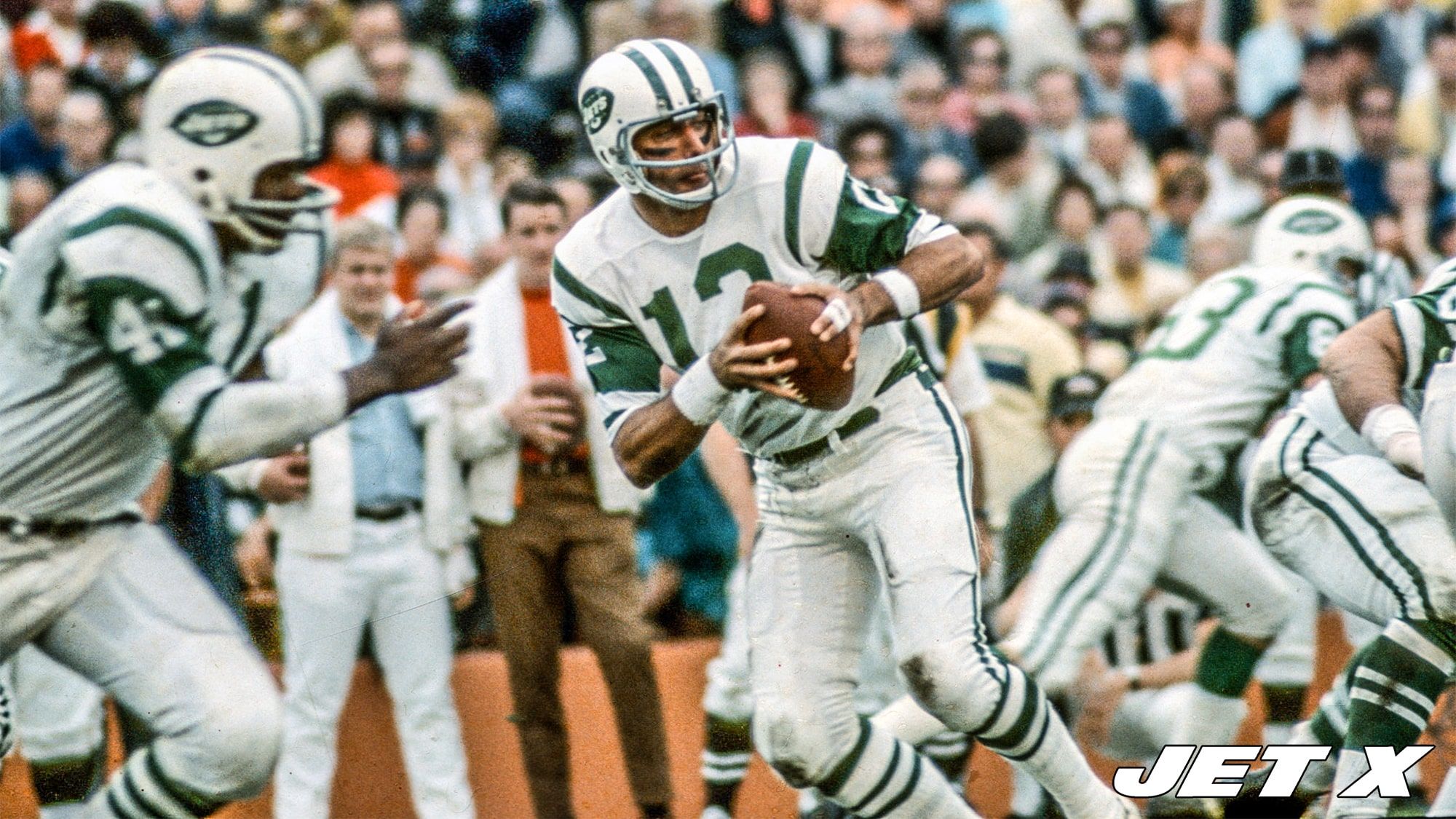
Quarterbacks
- Joe Namath
- Ken O’Brien
- Chad Pennington
Let’s not get into the whole “overrated Namath” debate. Everybody understands that his statistics leave something to be desired—even when compared to his era alone.
Namath finished his transformative NFL career with 27,663 passing yards 173 passing touchdowns to an overwhelming 220 interceptions (140 games played). Yes, quarterbacks threw more interceptions in those days. The great Johnny Unitas threw 253 interceptions in 211 games. Terry Bradshaw threw 210 picks in 168 games. But Namath’s interception-per-pass percentage of 5.8 ranks near the top of the all-time list. The only greats with a higher percentage include Sammy Baugh, Sid Luckman, Bobby Layne, George Blanda, Norm Van Brocklin, Bob Waterfield and Ken Stabler.
So, sure, there’s a case to be made that—through the annals of history—Namath is widely overrated. Then again, some individuals create such an impact that “overrated” has to be part of the discussion.
Namath belongs in the special class of all-time great football player. Not only was he one of the first true athlete celebrities, but he also changed the course of NFL history. His guarantee and subsequent delivery in Super Bowl 3 was the first in many steps that allowed the modern NFL to take shape.
Prior to the Jets’ stunning 16-7 victory over the Baltimore Colts, the AFL was considered a laughingstock in most authentic football circles. This nonsensical AFL-NFL World Championship Game was nothing more than an NFL talent showcase. That was largely true, of course, until Namath and the Jets did the unthinkable. A Kansas City Chiefs triumph in Super Bowl 4 allowed the merger to become a reality.
Joe Namath’s cultural and league importance cannot be matched by anybody. For that reason, he is far and away the Jets’ greatest all-time player.
The team’s backup is sort of an easy call. While Ken O’Brien could never match Dan Marino stride for stride and did come up with some funky games during the 1986 season—eventually leading to his benching prior to the playoffs—No. 7 put up the statistical numbers that put him in the two-hole.
O’Brien’s 24,386 passing yards rank him second behind Namath’s 27,057. His 124 passing touchdowns also rank him second in team history behind Namath’s 170.
The really tough call at quarterback comes at No. 3, and quite honestly, there are four throwers who have a legitimate claim.
Richard Todd ranks third in passing yards all-time and can also claim two playoff victories. Mark Sanchez leads the organization’s history with four tournament wins. Vinny Testaverde will forever remain a fan favorite, as his 29 touchdowns in 1998 broke a single-season record (later broken by Ryan Fitzpatrick in 2015).
In the end, we went with Chad Pennington. If not for injuries, who knows what some of those Herm Edwards do with the Marshall product at the helm. Though he never reached the AFC championship game, Pennington played in five playoff games, winning two. As part of the magical 2002 season, No. 10’s rise to stardom was something special.
Snubs: Richard Todd, Vinny Testaverde, Mark Sanchez
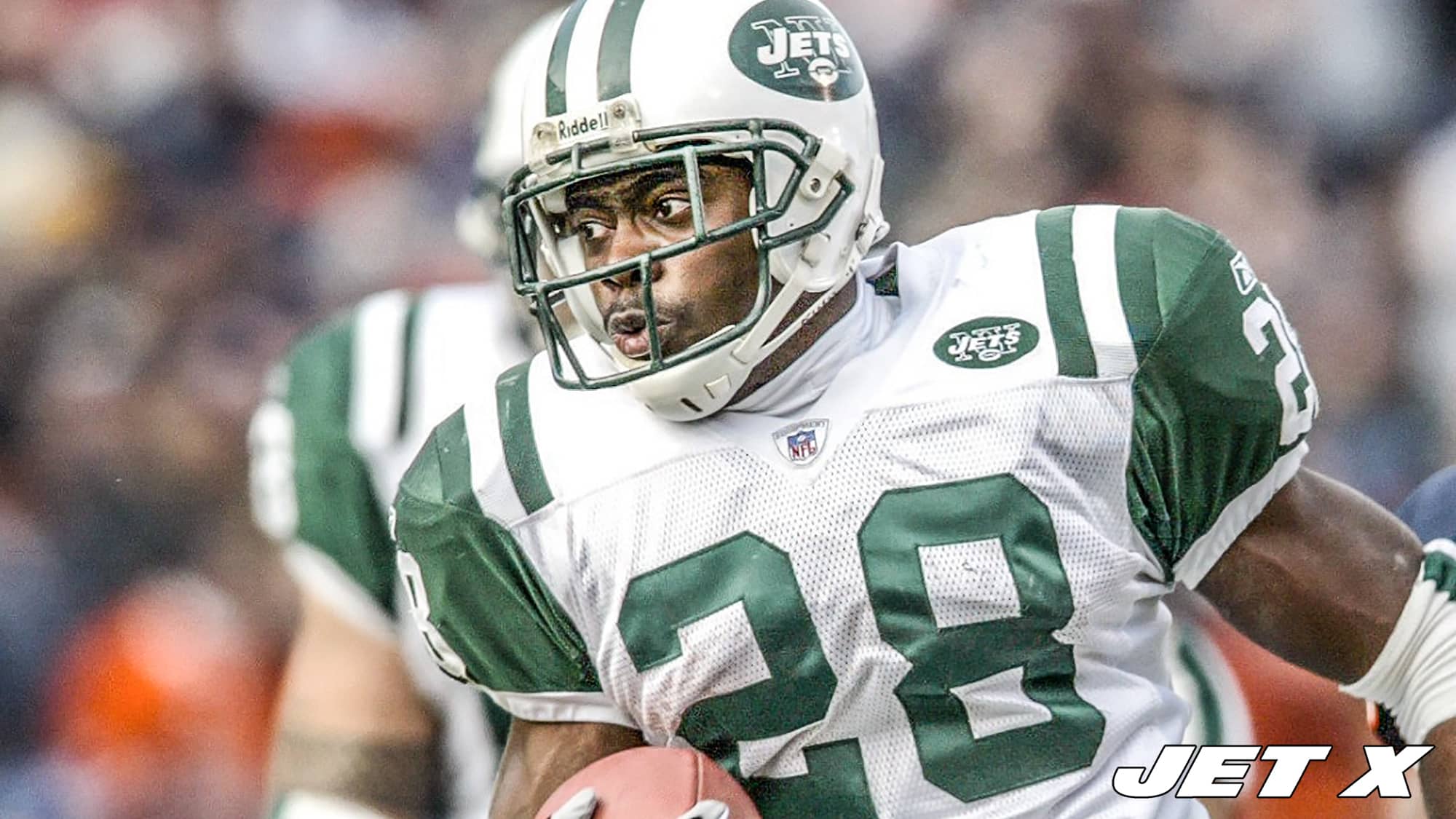
Running Backs
- Curtis Martin
- Freeman McNeil (3DB)
- Emerson Boozer
Curtis Martin is our workhorse, and there’s no question about it. The Jets’ all-time leading rusher (10,302 yards) also holds the record for most rushing touchdowns (58). Martin is fourth all-time in total touchdowns.
What Bill Parcells did prior to the 1998 season in acquiring Martin is something no general manager would do in today’s value-driven league. Thanks to today’s non-workhorse flavor, the running back position has gone the rotational route. This wasn’t the case in Martin’s day, and his presence helped lift the Jets to their first-ever AFC East division title in 1998 (first division title in the modern era).
Freeman McNeil was forced to endure boos and jeers on draft day, but the UCLA product was no bust. His 8,074 rushing yards with the Jets is the only number that’s within shouting distance of Martin.
McNeil will serve as the perfect third-down back when Martin needs a blow. He’s a weapon on the ground as well as through the air.
The third back on the roster is Super Bowl champion, Emerson Boozer. His 5,135 career rushing yards with the franchise rank him third all-time, while his 52 rushing touchdowns place him second. Interestingly, Boozer’s 65 total touchdowns place him third all-time behind only Maynard’s 88 and Walker’s 71.
Snubs: Johnny Hector, John Riggins, Thomas Jones, Bilal Powell, Adrian Murrell
Fullbacks
- Matt Snell
- Bill Mathis
The only man to score a Jets touchdown in the Super Bowl is definitely on this team. Matt Snell, a first-team All-Pro in 1969 and three-time Pro Bowler (or AFL All-Star equivalent), ranks fourth in team history with 4,285 yards.
A man who’s always forgotten manages to sneak on the team as the fifth running back. Yet, there isn’t a soul in the world who’d argue against Bill Mathis making this team.
Mathis was this organization’s first true star. For the then-New York Titans in 1961, the old-school player put up 846 yards and seven touchdowns in just 14 games in an All-Pro campaign.
The competition between Mathis and Richie Anderson was a fierce one, but the old vet and Super Bowl champ prevails. I nearly added Anderson to the roster as a third fullback, while removing one of the three tight ends, but held off. Although Anderson could easily play some tight end, holding three fullbacks is too nutty.
Snubs: Richie Anderson, Brad Baxter, Tony Richardson
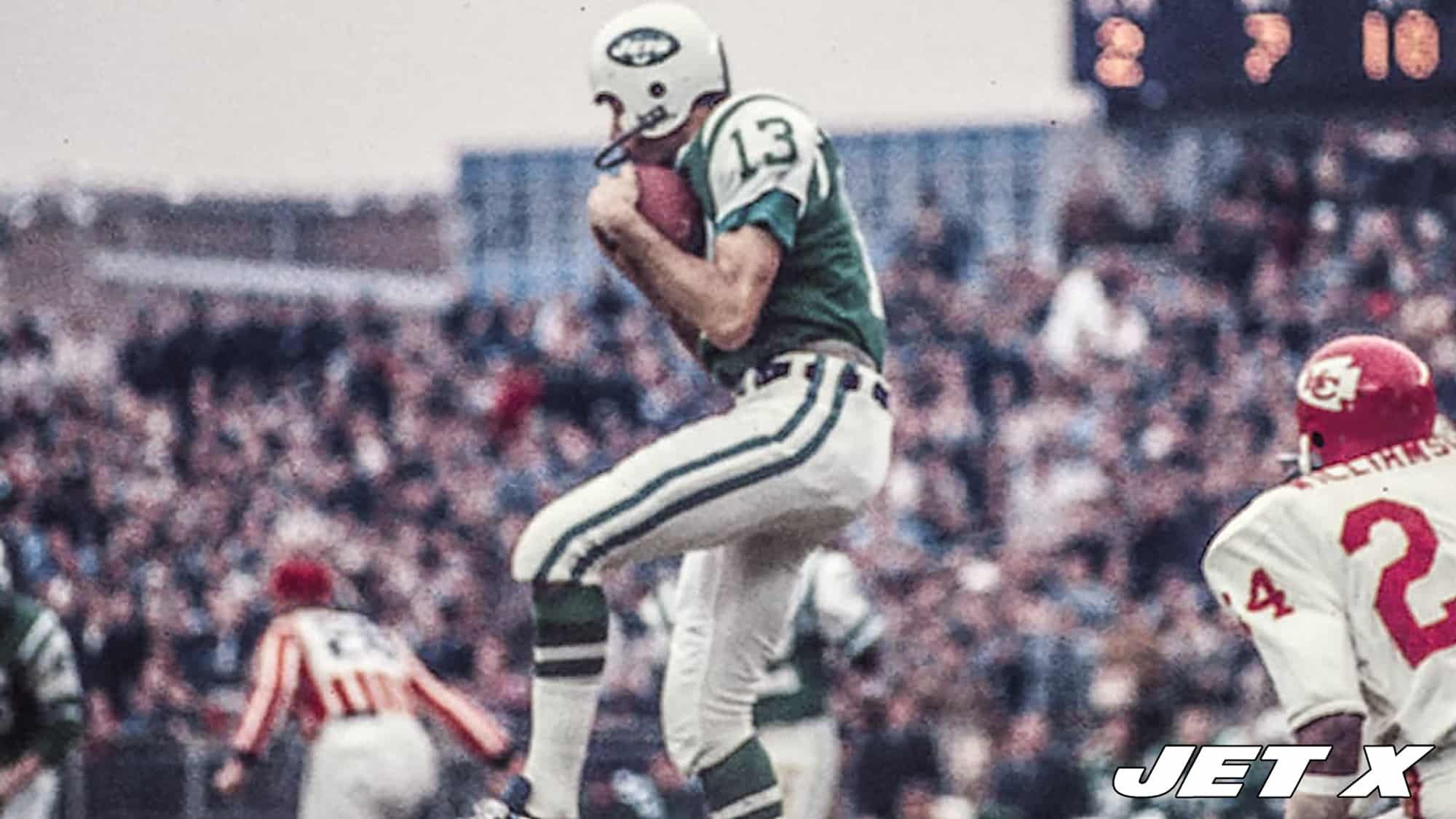
Wide Receivers
- Don Maynard (Z)
- Wesley Walker (X)
- Wayne Chrebet (H-SLOT)
- Al Toon
- George Sauer
First, Richie Anderson, now Laveranues Coles—it doesn’t get much tougher than that. Of all the snubs on the list, those are the two that sting the most.
First, let’s start at the top. Don Mayard is 1B to Namath’s 1A in Jets history. The southern gentleman from Crosbyton, TX is one of just five “full-time” Jets Hall of Famers (Namath, Martin, Winston Hill and Kevin Mawae). His 11,732 receiving yards obviously put him atop the Jets all-time list, but it also places him 30th in league history (still, after all these years of pass-happy rule changes).
Maynard was the first to ever reach 10,000 receiving yards and retired as the league’s all-time leading receiver until Charlie Joiner passed him in 1986. His 88 touchdowns still stand as the most in Jets history, as do his 627 receptions.
While Maynard is a breeze at Z, Wesley Walker is just as easy at X. The Cyclops, as he was commonly called, thanks to being legally blind in his left eye, ranks second in team history in receiving yards (8,306) and touchdowns (71).
After the top two is when it becomes tough. But no matter which direction one chooses, the slot-man is easy to spot.
Wayne Chrebet takes the No. 3 spot and will play the slot in 11 personnel. The man who ranks second in franchise history with 580 receptions and who had more receptions than anybody over his first two seasons in the league, brings with him a story that’s impossible to beat.
The long-shot from Hofstra walked on with the Jets during the Summer of 1995 and never looked back. Tough as nails, Chrebet connected with the fanbase unlike anybody prior or since. His workmanlike, blue-collar, underdog-type effort is what has everybody still experiencing a sea of No. 80 jerseys at MetLife Stadium.
As it relates to Al Toon, “what if?” comes to mind. If not for injuries, what if? Toon might be the most talented player on this roster. He just couldn’t get it done in the most important area in football: availability. Nonetheless, Toon still ranks fourth in receiving yards (6,605) and third in receptions (517).
When a tiebreaker is needed, the team’s sole championship usually did the talking. It’s probably why George Sauer snagged the final spot. Although he trails Coles by nearly 1,000 yards in the receiving department, Sauer played just six seasons, earning Pro Bowl nods in four and All-Pro selections in two.
Keyshawn Johnson was another tough cut, but his four years, while impactful, don’t add up to Coles’s production, even. For instance, Coles’s top-two receiving seasons beat out Johnson’s with the Jets.
The other interesting candidates are Brandon Marshall, the Jets’ single-season receiving yards record holder, and a couple of old-timers in Art Powell and Blake Turner, who both didn’t play long enough with the franchise. Incredibly, Powell put up a 1960 season (the franchise’s first) worth 1,167 yards and 14 touchdowns (tied for the single-season record with Marshall and Maynard). And he did it in just 14 games.
Snubs: Laveranues Coles, Keyshawn Johnson, Jerricho Cotchery, Art Powell, Blake Turner, Rob Moore, Brandon Marshall
Tight Ends
- Mickey Shuler
- Rich Caster
- Jerome Barkum
Tight end isn’t a strong position for the Jets historically. Mickey Shuler is the unchallenged starter, a man who worked so well with O’Brien and those high-flying 1980s offenses.
Rich Caster and Jerome Barkum, two guys who played a good chunk of their careers together, round out the position. Barkum, a lighter tight end who weighed under 220 pounds, often played wide receiver, which is one of the reasons we felt comfortable rolling with just five wideouts.
Snubs: Pete Lammons, Dustin Keller, Johnny Mitchell
Tackles
- Winston Hill (LT)
- Marvin Powell (RT)
- D’Brickashaw Ferguson
Offensive tackle is as cut and dry as any position on the list. New-school Jets fans may yell at D’Brickashaw Ferguson’s reserve status, while old-school fans understand.
Marvin Powell’s career is still debated among Jets fan circles. Many believe he was as overrated a tackle as any. Others look at the three first-team All-Pro nods and five Pro Bowl selections and understand. Besides, Powell played right tackle, the position we needed opposite Hall of Famer Winston Hill.
Obviously, Brick shouldn’t be slept on. Although he qualified for just three Pro Bowls, the man never missed a snap. If not for a fluky end-of-season desperation shot at the end of the disappointing 2008 season, Ferguson plays every snap for the green and white.
Snubs: Sherman Plunkett
Guards
- Randy Rasmussen (LG)
- Dave Herman (RG)
- Jim Sweeney
While not as decorated as the tackle group, the Jets’ guard situation is another healthy-looking position room. Both Randy Rasmussen and Dave Herman blocked for the team’s lone Super Bowl champions, and Jim Sweeney was a constant presence for 11 long years.
An argument could be made for old-timer Bob Mischak. Although he played just three seasons for the organization (1960-62), he made two Pro Bowls (AFL All-Star teams) and two first-team All-Pro squads.
Big Brandon Moore, a one-time Pro-Bowler himself, also garnered serious consideration for the third spot.
Snubs: Bob Mischak, Brandon Moore, Dan Alexander, Alan Faneca
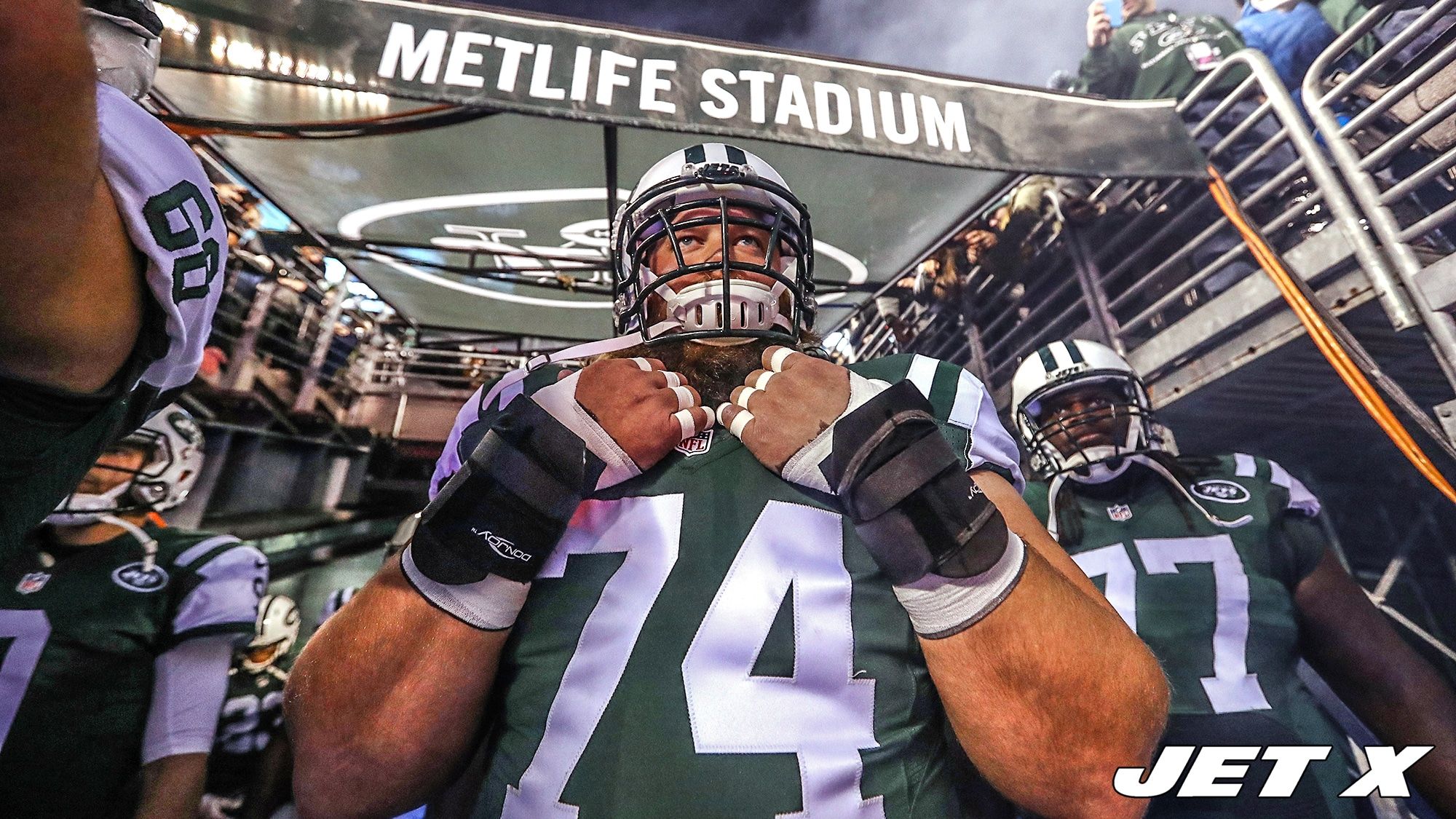
Centers
- Nick Mangold
- Kevin Mawae
- Joe Fields
In the end, we went with three centers in order to get the offensive line number up to nine. Nick Mangold and Kevin Mawae are unquestioned.
Mangold’s interesting blend of bubbly personality off the field and nasty demeanor on it paved the way for Rex Ryan’s memorable run. As to who starts, it’s honestly a flip of a coin. Mangold’s accolades include seven Pro Bowls and two first-team All-Pros. Mawae, a now-Hall of Famer, made six Pro Bowls and received two first-team All-Pros while with the Jets.
What decided the starting gig was other clothing. Although Mawae is certainly considered a Jet, he did start in Seattle before Bill Parcells smartly snagged him. He then finished in Tennessee after playing eight years in New Jersey. Mangold, on the other hand, played all of his 11 years with the Jets.
Mangold gets the start, but if the offense wants to get the screen-game going or start to attack the defense east-west with a pulling center leading the way, Mawae will jump in there. Besides, there’s no question that an attempt to start Mawae at one of the guard spots will be made in training camp.
From 1975 through the 1987 season, Joe Fields held down the center position. He was at his best in the early 1980s when the New York Sack Exchange was doing its thing and the Jets were shocking teams en route to the 1982 AFC championship game.
Snubs: N/A
Interior D-Linemen
- Joe Klecko (3-TECH)
- Marty Lyons (1-TECH)
- John Elliott
- Jason Ferguson
From offensive line to defensive line, Jets history is stacked with quality football players that made their living in the muddy trenches. Playing a 4-3, what the 2021 Jets will feature and what the Super Bowl team did as well, Hall of Fame snub Joe Klecko starts at the 3-technique.
No Jet has been hurt by the sack department more than Klecko. A Pro-Bowler at three different positions (defensive tackle, defensive end and nose tackle), Klecko’s official sack tally reads 24. In reality, Klecko sacked the quarterback an unofficial 77.5 times. This number would rank him first on the official Jets sack list. Yet, it would most likely second behind the sack numbers that would be tacked onto Mark Gastineau’s 74 official sacks. Klecko’s unofficial sack number includes his monster 1981 season that saw him get to the quarterback 20.5 times.
That year is when the New York Sack Exchange took shape with Klecko leading the way. He was the third man to have his number retired by the team (Namath and Maynard) and remains one of the most beloved players in franchise history.
The man who did a lot of the dirty work (alongside Abdul Salaam, who’s a hard-luck cut on this roster), Marty Lyons, will start at the 1-tech. Interestingly, Lyons wasn’t that big of a player. Clocking in around 269, Lyons played both inside and outside, similar to Klecko.
Starting two “lighter” defensive tackles means we need a big guy in the rotation, and luckily for us, the options are plentiful. Sione Pouha, Damon Harrison and Kris Jenkins are all viable if not overly-deserving options. But a Parcells favorite, Jason Ferguson, gets the nod as our must-have 300+ pound big heavy. Ferguson simply ate up rushing attacks in the late 1990s and did so while following the Big Tuna to Dallas and then Miami.
With Ferguson snagging the fourth spot, unheralded defensive tackle (another lighter tackle) John Elliott rounds out the group. This three-time Pro-Bowler (three-time AFL All-Star), one-time first-team All-Pro member and Super Bowl champion is yet another guy who can play inside and out.
Snubs: Sione Pouha, Abdul Salaam, Muhammad Wilkerson, Damon Harrison, Kris Jenkins
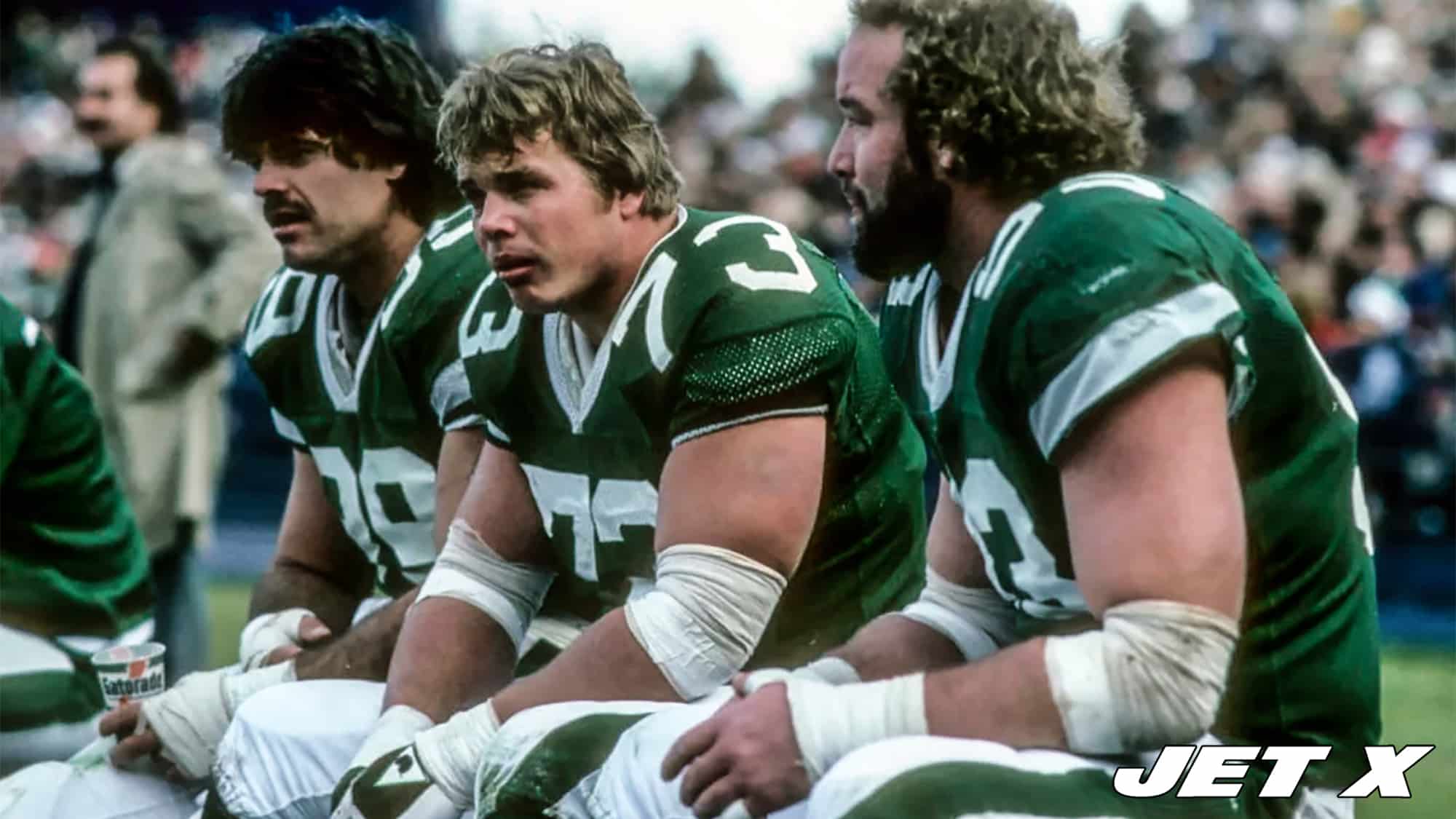
EDGE
- Mark Gastineau
- Gerry Philbin
- John Abraham
- Shaun Ellis
- Verlon Biggs
With five edge players, the Jets’ all-time team is coming to the party with nine defensive linemen and a lot of versatility. Three of the four defensive tackles can also play outside, while Shaun Ellis can kick inside anytime he’s asked.
Ellis compiled 72 sacks over the course of his 11-year Jets career. As one of the four first-round picks in 2000, Ellis was a steady hand for the organization over the course of four coaching regimes.
Obviously, Mark Gastineau is our top dog here. His ridiculous and NFL record-breaking 1984 season that saw him put up 22 sacks complemented his 19-sack 1983 campaign. It made him a household name and a man other teams and other teams’ fans loved to hate.
The competition at No. 2 is fierce here. Should it be Gerry Philbin, the Super Bowl champ whose sack number remains unknown? Or should it be John Abraham, the last dominant edge rusher the Jets have employed? Abraham’s 53.5 sacks rank him this in Jets history, but his injury worries oftentimes frustrated fans. Meanwhile, Philbin racked up an unofficial 19 sacks during the Jets’ championship 1968 season and qualified for two-straight first-team All-Pros (1968 and 1969).
Philbin’s championship experience gives him the starting nod, but Abraham will play just as much, especially in the sub-package.
Lastly, some Jets fans might recoil or squint at the fifth man in the mix here, but he’s deserving of a spot, nonetheless. Verlon Biggs is a man who felt disrespected by the Jets organization following their Super Bowl win. It ultimately led to his final four NFL seasons coming in Washington.
But make no mistake: Biggs was a dominant defensive lineman. He was a three-time AFL All-Star with the Jets, a Super Bowl champion, and he also became a key component to Washington’s Over The Hill Gang in the early 1970s.
Snubbing both Dennis Byrd and Calvin Pace was a tough decision. Pace’s sneaky 46 sacks rank him fifth on the Jets all-time leaderboard.
Snubs: Dennis Byrd, Calvin Pace, Marvin Washington, Jeff Lageman, Bryan Thomas, Hugh Douglas
Linebackers
- Larry Grantham (SAM)
- Mo Lewis (WILL)
- Al Atkinson (MIKE)
- Kyle Clifton
- David Harris
- Greg Buttle
New York’s history is loaded at linebacker. First and foremost, Larry Grantham is the top dog yet is oftentimes disrespected. When the Jets asked the fans to vote on the all-time starting team last year, Grantham was nowhere to be found. In the Jets X-Factor world, that’s a football sin.
The five-time Pro-Bowler (AFL All-Star) and five-time All-Pro started his NFL career when the Jets commenced their existence. He was there from the start and it ultimately paid off in the form of a championship.
Versatile Mo Lewis, who can also drop down on the edge for us, gets the nod at WILL. Fourth all-time in sacks (52.5) and second all-time in tackles (1,011), Lewis remains a fan-favorite today.
One of the leaders of the Super Bowl 3 team, Al Atkinson, will man down the MIKE. The starting MIKE job came down to Atkinson and another fan-favorite in David Harris, but the former barely edged him out.
The final two spots belong to old-timer Greg Buttle, Mr. Jet himself, and special teams maniac Kyle Clifton, whose 1,468 solo tackles ranks No. 1 in team history.
Snubs: Marvin Jones, Lance Mehl, Ralph Baker
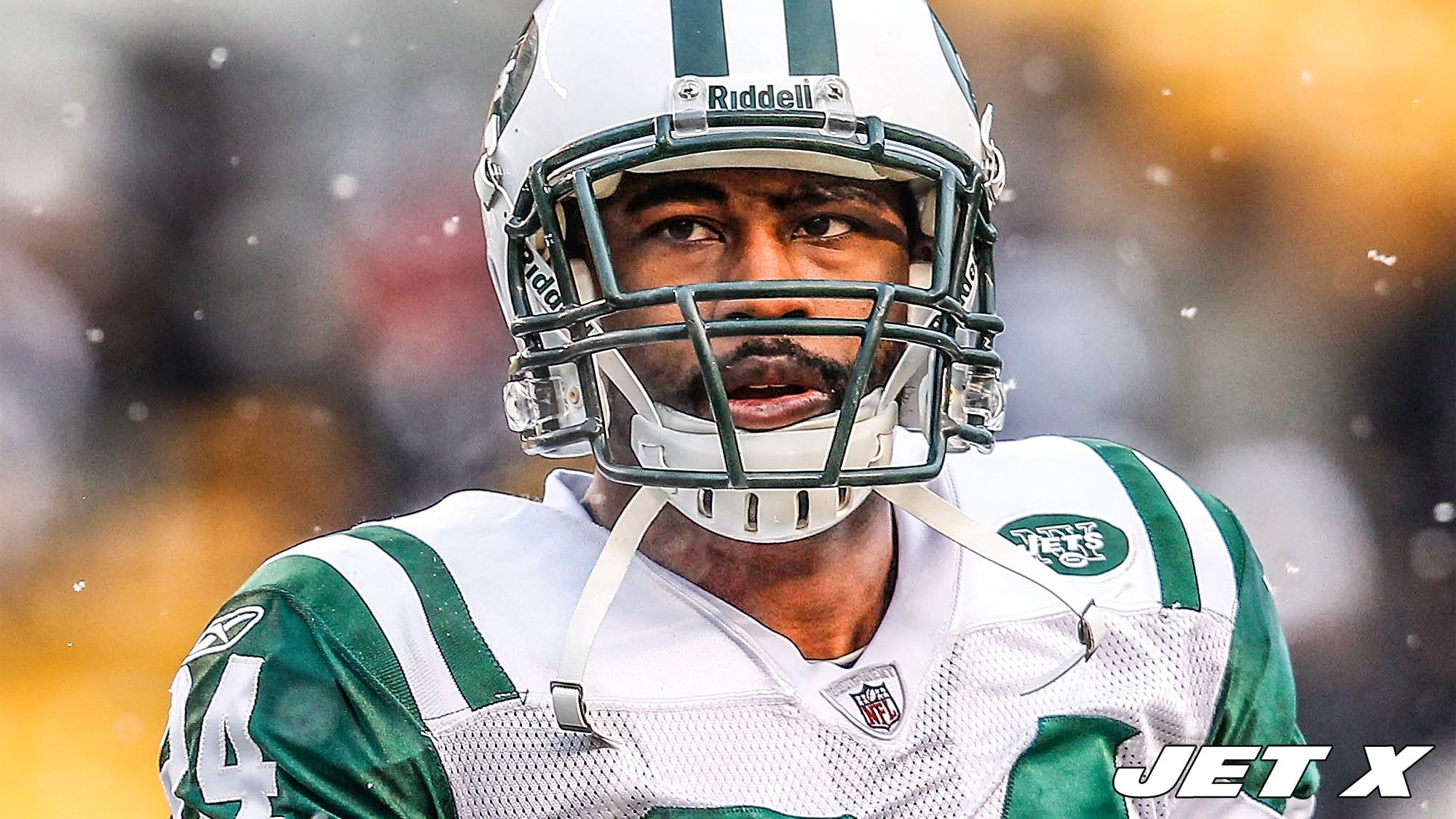
Cornerbacks
- Darrelle Revis
- Aaron Glenn
- Bobby Jackson (SLOT)
- James Hasty
- Antonio Cromartie
Here comes the challenging part of the roster: the defensive backs. Unfortunately, Jets history isn’t littered with great cornerbacks and safeties. So, while it’s tempting to limit the numbers, keeping the numbers at five apiece is fair.
There’s really no need to dig into Darrelle Revis’s career. He’s a sure-fire Pro Football Hall of Fame player and might go down as the most dominant cover-corner in NFL history (this side of Deion Sanders). No cornerback in NFL history will ever match what Revis did between 2008 and 2011.
Aaron Glenn’s No. 2 status is as safe as any position on the roster, but then it’s time to dig deep. Who in the world should be the third corner, a slot corner, no less?
Ray Mickens was tempting, as we watched his under-the-radar brilliance often during the Parcells, Al Groh and Herm Edwards years. Glenn has the skill set to play slot, but who would start opposite Revis on the outside? James Hasty, maybe?
We went with Bobby Jackson. A sixth-round pick in 1978, Jackson immediately started and made a significant impact, intercepting five passes. He then followed that All-NFL Rookie Team campaign up with four picks in 1979. Though there wasn’t much slot to be played back then, his 5-foot-9 frame and shifty intangibles should allow him to be our nickel back.
Hardnosed James Hasty fills in the fourth spot while ultra-talented Antonio Cromartie rounds out the group. A serious battle between Cromartie and Johnny Sample existed, but the former enjoyed a longer, more impactful Jets career and can do so many more things for this team (kick return duties included).
Snubs: Johnny Sample, Randy Beverly, Dick Felt, Ray Mickens (Slot)
Safeties
- Jamal Adams (SS)
- Bill Baird (FS)
- Victor Green
- Dainard Paulson
- Erik McMillan
Is it actually possible to call Jamal Adams the greatest Jets safety of all time? Yeah, I think it is.
Most Jets fans won’t want to see this—as the sting of his 2020 offseason actions was too much—but the impact he delivered in just three seasons surpasses anything any other Jets safety has done. Only two Jets’ defensive backs have ever been named a first-team All-Pro. One is named Revis, who accomplished that feat three times. The other is Jamal Adams.
New-school fans would probably want to see Victor Green start at the other safety spot, but Green and Adams together is a complete no-no. Those are two box safeties who prefer mucking it up in the box over taking single-high duties.
Super Bowl champ Bill Baird will man down the free safety spot with his franchise-record 34 interceptions. Yes, as previously written, interceptions were more common back in those days, but 34 is quite impressive, nonetheless.
A guy who played with Baird, Dainard Paulson, is the fourth safety. Paulson’s 29 Jets interceptions place him second all-time, four ahead of Revis and five clear of Green.
Two-time Pro-Bowler Erik McMillan rounds out the safety room.
Snubs: Jim Hudson, Kerry Rhodes, Brian Washington, Burgess Owens, Darrol Ray, Ken Schroy
Special Teams
- Pat Leahy (K)
- Curley Johnson (P)
- Leon Washington (KR/PR)
In sticking to the guidelines, we must roll with three special teams players. So far, we presented a balanced look: 25 offensive players and 25 on the defensive side. Here, the third special teams guy can come in any form.
How it could be anybody other than Leon Washington? Sure, Bruce Harper has a legitimate claim. Brad Smith does as well. James Dearth does also—if the long-snapper route is taken.
It’s Washington in the end for a couple of reasons. Firstly, we’ll get one of the tight ends or offensive lineman to snap the ball. It’s not as easy as one would think, but we’ll return to the old school for our long-snapper. In terms of a gunner, we’re covered with backup corners and receivers. Sauer, Hasty and Cromartie can easily get the job done, as will Clifton and Buttle when running kickoffs down in a maniacal fashion.
More importantly, Washington is one of the best return men in NFL history. The man snagged first-team All-Pro honors in 2008 when he racked up a league-leading 2,332 all-purpose yards, sported a 25.6 kickoff return average, and took one back to the house. And this season was off the heels of a 2007 campaign that saw him take three kickoff returns for touchdowns.
The kicking job came down to two guys, Pat Leahy and Jim Turner. Considering Pat Leahy is the organization’s all-time leading scorer by a wide margin (1,470 points to Nick Folk’s 729), he gets the nod.
Turner’s Super Bowl-winning teammate, Curley Johnson, barely edges out Tom Tupa for the punting job.
Snubs: Jim Turner (K), Tom Tupa (P), Bruce Harper (KRPR), Brad Smith (KR), James Dearth (LS), Tanner Purdum (LS), JoJo Townsell (KR), Justin Miller (KR)
Coaching Staff
- Weeb Ewbank (HC)
- Joe Walton (OC)
- Rex Ryan (DC)
- Mike Westhoff (STC)
- Walt Michaels (Assistant HC)
There’s no question who’s coaching this team. It’s Weeb Ewbank, without discussion or hesitation. Sure, having Bill Parcells run the sideline is any football fan’s dream, but his short three-year tenure that ended in Bill Belichick’s frightening reign of terror in New England sort of dampers the mood for tuna.
Finding an offensive coach for the offensive coordinator job was a tough chore, as most of the Jets’ best coaches have been defensive-minded guys. Walton’s offense often underwhelmed, but he’s the de facto offensive play-caller.
Rex Ryan as the defensive coordinator is a no-brainer. Let him do his thing from the 4-3 (sorry, Rex, not a 3-4 with this squad) with Walt Michaels over his shoulder.
Lastly, there’s no better special teams coach than Mike Westhoff. There’s also no better personality (pop in the 2010 Hard Knocks tape). From 2001 through the 2012 season, Westhoff brilliantly coached the franchise’s special teams units.
Front Office
- Bill Parcells (GM and President)
- Jim Kensil (Assistant GM and Vice President)
- Mike Tannenbaum (Salary-Cap Specialist)
- Eric Mangini (VP of Player Personnel)
Based on the Jets’ front office history, allowing Parcells to run the show makes the most sense. Who is that great general manager who deserves the job? Ewbank controlled personnel during the golden era. Dick Steinberg in the early 1990s and Dick Haley a little later don’t exactly inspire the masses. Neither does Terry Bradway, a man who inherited Parcells’s roster and didn’t do much with it.
It has to be Parcells. Jim Kensil can help in the front office as another suit, while Mike Tannenbaum helps on the financial side of things. One of the greatest Jets’ mysteries of all time is Mikey T., a man whose decisions with Eric Mangini were brilliant yet dumbfounding when Rex entered the building. For that, Mangini is tagged with the VP of Player Personnel.
We could have gone the Bill Belichick route as defensive coordinator but decided to stay away.
New York Jets All-Time Team At A Glance
- QB: Joe Namath, Ken O’Brien, Chad Pennington
- RB: Curtis Martin, Freeman McNeil (3DB), Emerson Boozer
- FB: Matt Snell, Bill Mathis
- WR: Don Maynard (Z), Wesley Walker (X), Wayne Chrebet (H-SLOT), Al Toon, George Sauer
- TE: Mickey Shuler, Rich Caster, Jerome Barkum
- T: Winston Hill (LT), Marvin Powell (RT), D’Brickashaw Ferguson
- G: Randy Rasmussen (LG), Dave Herman (RG), Jim Sweeney
- C: Nick Mangold, Kevin Mawae, Joe Fields
- DT: Joe Klecko (3-TECH), Marty Lyons (1-TECH), John Elliott, Jason Ferguson
- EDGE: Mark Gastineau, Gerry Philbin, John Abraham, Shaun Ellis, Verlon Biggs
- LB: Larry Grantham (SAM), Mo Lewis (WILL), Al Atkinson (MIKE), Kyle Clifton, David Harris, Greg Buttle
- CB: Darrelle Revis, Aaron Glenn, Bobby Jackson (SLOT), James Hasty, Antonio Cromartie
- S: Jamal Adams (SS), Bill Baird (FS), Victor Green, Dainard Paulson, Erik McMillan
- ST: Pat Leahy (K), Curley Johnson (P), Leon Washington (KR)
Updates:
Guard Dan Alexander, safety Jim Hudson and safety Kerry Rhodes have been added to the subs list at each position.


